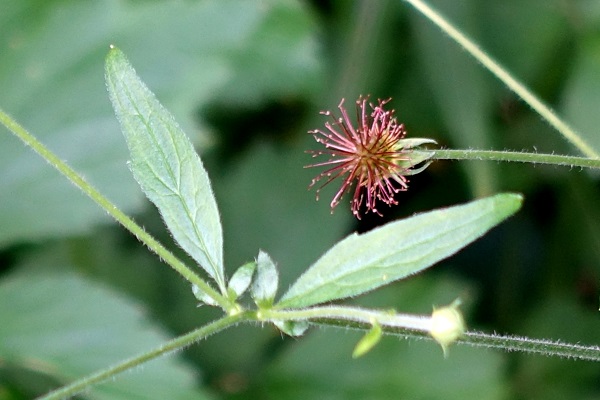Hebrew: גיאון היערות, Arabic:حشيشة المبارك المدينية
| Scientific name: | Geum urbanum L. | |
| Synonym name: | Geum rivale subsp. urbanum Á. Löve & D. Löve | |
| Common name: | Wood Avens, Bennet's Root, Old man's whiskers, Herb bennet | |
| Hebrew name: | גיאון היערות | |
| Arabic name: | حشيشة المبارك المدينية | |
| Family: | Rosaceae, Rose family, משפחת הורדיים או ורדניים |

|
| Life form: | Perennial | |
| Spinescence: | Non-spinescence | |
| Succulence: | Non-succulent | |
| Stems: | Height 30-70cm,upright | |
| Leaves: | Basal rosette, alternate, stalked, stipulate; stem leaves’ blade palmate, with 3 leaflets or 3-lobed | |
| Inflorescence: | Sparse corymb, flowers erect, 3–18-flowered | |
| Flowers: | Corolla regular (actinomorphic), pale yellow, approx. 10–15 mm broad; petals 5, elliptic, 4–7 mm long; Calyx 5-lobed, with epicalyx; Stamens many; Gynoecium separate, pistils several | |
| Fruits: | Achene with hooked hairs; each flower gets about 70 fruits | |
| Flowering Period: | June-August | |
| Habitat: | Batha, Phrygana | |
| Distribution: | Mt.Hermon | |
| Chorotype: | Mediterranean + Euro-Siberian | |
| Summer shedding: | Ephemeral |

Derivation of the botanical name: Geum, from the Greek geno, "to yield an agreeable fragrance". When freshly dug, the root has a clove-like aroma. It was called "the Blessed Herb" in earlier times and the common name "Herb Bennet" is a possible corruption of that. urbanum 'of a city' (urban!), and this is a very common 'weed' of cities, towns and villages.


*Pictures taken in Ragunda, Sweden (see: www.flowersinsweden.com/Geumurbanum_page.htm). |